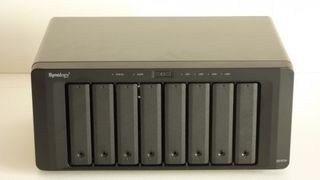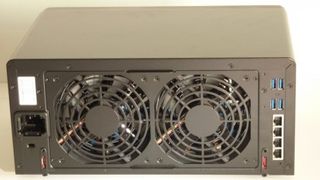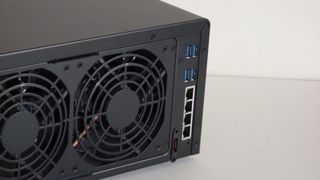TechRadar Verdict
A powerful and flexible network storage device that be used in a multitude of ways to benefit your business.
Pros
- +
Superb DiskStation Manager software
- +
Fantastic build quality and physical design
- +
Expandable to a whopping 108TB via external eSATA units
Cons
- -
Lacks 10GbE
- -
LACP switch adds to the cost
- -
Some areas of CPU-bound performance slightly disappointing
Why you can trust TechRadar
Aimed at both business and home users in need of gigantic amounts of storage, the DS1815+ is an eight-bay NAS from Synology, powered by a quad-core CPU and up to 6GB of memory. This places it at the very opposite end of the performance scale from the single-bay DS115J that came out late last year.
With a retail cost of around £850 (US$1030, AU$132) it's at the upper end of NAS pricing, although one step below the level occupied by rack-mount NAS units, such as the Thecus NN810U-G or Synology's 12-bay RackStation RS3614xs+.

There's space for eight hot-swappable 3.5-inch or 2.5-inch disks, which offers up to 48TB of internal storage (when using 6TB hard disks) and this can be extended further by purchasing a pair of external five-bay DX513 modules, which connect to the unit's two eSATA ports at the back. Therefore, if you need it, the DS1815+ offers up to 108TB of storage space. The DS1815+ also support hardware-based encryption of your entire file system.

It has four gigabit ethernet ports, which can be configured for redundancy in case of failure, or together via link aggregation to offer up to 4Gbit/sec of bandwidth. And as with any Synology NAS, it comes with DiskStation Manager, the company's excellent Linux-based NAS operating system, which currently sits at version 5.1.
Appearance and design
If you're familiar with Synology's NAS range, the DS1815+ will be instantly recognisable, as it looks just about identical to the DS1813+. The unit measures 340mm across, and comes in a very strong plastic case, which doesn't take up too much space under a desk or on a shelf. The eight removable bays are accessible at the front. At the bottom of each disk bay is a green status LED, with additional indicators for the LAN ports, an alert notifier and power at the top.

There are four USB 3 ports at the back along with the two eSATA ports, a pair of large fans and an internal power supply, so a standard "kettle" lead is all you need to get it up and running.
The DS1815+ is powered by a quad-core Intel Atom C2358 processor, which runs at 2.4GHz, a chip which should be enough to cope with many users simultaneously. There are two memory slots, one occupied by a 2GB DDR3 SODIMM as standard.
Disk installation is completely free of tools and screws. You secure the disk into the bay by pushing two black plastic strips into the mounting holes, pushing the disk into the units, then closing the plastic cover. To remove them, a quick press of the front pops the cover up and you can easily slide the disk out.
Since plastic can break, I thought it a good idea to look at how to replace a broken mounting bracket, if the need arose. Synology lists lots of spare parts on its website, but you can't order them directly. Instead the company says to locate a reseller, who should be able to help.
The trump card of all Synology's NAS products is DiskStation Manager, the excellent Linux-based operating system that powers them. It offers a familiar Windows-like environment, accessible via a browser, with groups of icons and menus to navigate around the system and widgets to provide at-a-glance information, such as internal temperature, CPU utilisation, and so on.
The software functions just about identically on the high-end model like the DS1815+ as it does the lower end units, but there are some subtle differences in what it can do.
If you set up a download manager for torrent files and so on, the number of concurrent downloads is limited with a NAS such as the DS115J, but the DS1815+ lets you run up to 80 at the same time.
Similarly, DiskStation Manager lets you run a web server from your NAS, with support for SQL databases, WordPress, Drupal, Joomla, and so on. With a low-end unit, the limited CPU and memory resources restricts what you can do. It might be useful as a development server, or for use on an intranet with a small number of clients, but with the beefed-up network and processing performance offered by the DS1815+, you can host a site with a larger number of users.
This is really just scratching the surface of DiskStation Manager. As well as full domain and Active Directory support, there's a built-in firewall, Telnet, SSH, FTP, iSCSI, all sorts of traditional RAID modes in addition to Synology Hybrid RAID, although not RAID 50 or 60, as with the Thecus N8810U-G.
And there are numerous plugins and software packages to extend the functionality of the DS1815+, accessible via a browser within DiskStation Manager.

